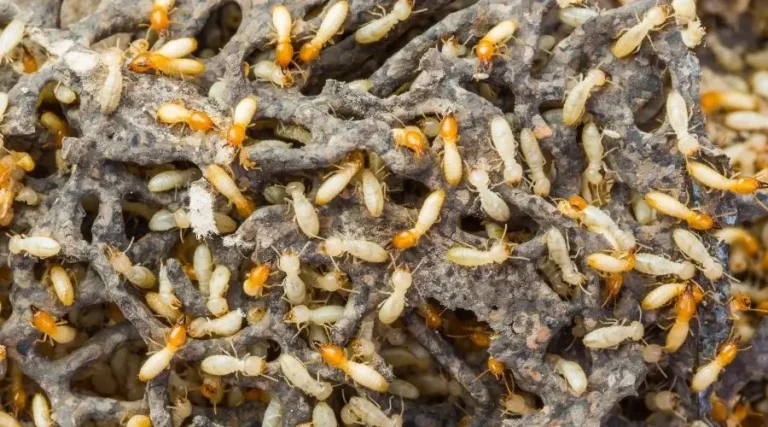Termites are tiny insects that can silently destroy homes and buildings by chewing through wood, which can be expensive. In California, where it’s warm, the way buildings are made can make it easy for termites to move in, so it’s important to stop them before they cause too much damage. Let’s talk about how people deal with termites in California, how common they are in homes, signs that they might be around, the different kinds of termites, and ways to get rid of them.
Need Pest Control Services in Carlsbad, California? Turn to Carlsbad Pest Control for excellence! Our skilled professionals conduct meticulous inspections at your convenience, devising personalized solutions for your pest concerns. Forget about size-based pricing—we provide transparent explanations for practical and reasonable treatment costs.
Are termites common in California homes?
Yes, termites are indeed common in California homes. The state’s mild climate, with its relatively warm temperatures and moderate humidity, provides an ideal environment for termite activity year-round. Additionally, the prevalent construction styles, such as wood-framed structures and subterranean foundations, further contribute to the susceptibility of homes to termite infestations.
How are termites treated in California?
In California, dealing with termites usually means using a mix of prevention and ways to kill them. Pros who work in pest control use different methods, such as liquids, traps, fumigation, and barriers, to eliminate termites. They choose the best method depending on how bad the termite problem is in each place.
Signs of Termites to Look Out For
It’s critical to recognize the early indications of a termite infestation for prompt intervention. Some common indicators include:
- Mud Tubes: Termites construct mud tubes along walls, foundations, and other surfaces for shelter and protection as they travel between their nests and food sources.
- Wood Damage: Look for hollow-sounding or deteriorated timber, particularly in damp spaces like basements, attics, and crawl spaces.
- 3. Discarded Wings: Swarmers, reproductive termites, often shed their wings near windowsills and light sources after mating.
- Frass: Termite droppings, also known as frass, resemble small, pellet-like debris and can indicate the presence of an active infestation.
- Swarmers: During the mating season, winged termites may emerge indoors or around the property, signaling the establishment of a new colony.
Types of Termites
In California, the most common types of termites encountered include:
- Subterranean Termites: These termites build nests underground and access structures through mud tubes. They are particularly destructive and can cause significant damage if left unchecked.
- Drywood Termites: Unlike subterranean termites, dry wood termites infest dry wood structures without needing contact with soil. They often establish colonies within wooden furniture, framing, and siding.
5 Effective Treatment Options for Termite Control in California
- Liquid Termiticides: Liquid termiticides are a common way to control termites in California. These chemicals are put in the soil around a home or where termites are seen. Once sprayed, they make a barrier that stops termites from getting in and kills off any existing termite colonies. Experts who handle pest control carefully check the area and use the right amount of termiticide to ensure it works well.
- Termite Bait Systems: Another way to deal with termites in California is using bait systems. These systems have bait stations put in places where termites are active around the property. The bait inside the stations is tempting for termites. When termites eat the bait, they take it back to their colony, wiping it out. Termite bait systems are often part of a bigger plan to manage termites and need regular checking by pros to ensure they do their job.
- Fumigation: When termites are all over a building, fumigation might be needed. This means the whole building gets covered with a tent, and gas is pumped inside to get into the wood and kill the termites. Fumigation is very effective for big termite problems and reaches all the hard places to get to. But licensed fumigators must plan it well to keep people and pets safe.
- Wood Treatment: People can treat wooden surfaces with special chemicals during building or fixing up projects to keep termites away. These treatments make a shield that termites can’t get through. Some treatments use borate, which is harmful to termites but safe for people and pets when used correctly. It’s important to check treated wood regularly to ensure it’s still protected from termites.
- Physical Barriers: Using metal screens and termite-proof materials during building or fixing can stop termites from entering a home. These barriers make it hard for termites to find a way in. Using materials that termites don’t like, such as concrete or steel, can also lower the chance of termites moving in. Ensuring barriers are put up right and in good shape is key to stopping termites from causing damage.
Termite control is a critical aspect of homeownership in California, where the risk of infestation is ever-present. Homeowners can effectively protect their properties from these destructive pests by understanding the treatment options available and remaining vigilant for signs of termite activity. Whether by using preventative measures or expert pest control services, investing in termite control is an investment in your home’s long-term integrity and value. Don’t let termites silently diminish your property’s worth—take proactive steps today to ensure its protection for years.

